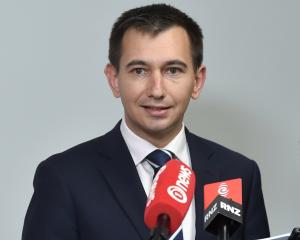
Australian mining company Santana Minerals has had a new $4.4 billion gold mine in Bendigo included in the Fast-track Approvals Bill, while OceanaGold has had a staged expansion of its gold mine at Macraes included.
While mayors of the districts directly impacted by the mines’ operations were measured in their reaction to the news, they were generally clear the mines would have a positive economic impact in the South.
Waitaki District Mayor Gary Kircher said Macraes was "a major project" and a "very significant contributor" to Waitaki’s economy.
"So we’re certainly in favour of, in general ... seeing that economic benefit continue for our district."
Its inclusion in the Bill provided ongoing certainty for the significant number of employees who lived in the Waitaki District, and also provided opportunities for others, he said.
Dunedin Mayor Jules Radich said the area at Central Otago where Santana Minerals had proposed the mine was "pretty hidden from the public eye".
"Of all the places you could think of mining, it seems like a reasonable choice."
The merchants of Dunedin may be able to "capitalise" from the project, despite the workers being based in Central Otago, but he did not want to speculate on the economic difference either project could make.
OceanaGold was a "pretty responsible mining company" and Mr Radich expected Santana Minerals would be the same.
Central Otago District Mayor Tim Cadogan said the Santana mine would present some "challenging new territory" for the council to navigate when the time came.
It was his understanding the council had a role to speak for the community in the fast-track process.

While the mine would create work for some and have a "pretty significant" impact, a lot of the workers would likely be from outside the district.
Environmental and community groups were not so happy.
Anti-mine development group Sustainable Tarras spokeswoman Suze Keith said Santana Minerals was "an inexperienced Australian mining company who hasn’t ever deployed a mine in New Zealand" and its proposal was "highly risky".
The group was worried the local community would be excluded from any decision-making in the fast-track process and that decision-making would be uninformed, when there were major environmental, social and reputational impacts and risks from having mining activity in that area.
It was "highly concerning" that key decisions were not yet finalised and key information was not yet available to the locally affected community only five months out from formal submissions, Ms Keith said.
Forest & Bird Otago-Southland regional conservation manager Chelsea McGaw said there were quite a few threatened and at-risk species that would be put in harm’s way by Santana Minerals’ proposed mine, including six nationally critical species, a nationally endangered fish and a plant species, along with 40 other plants and animals which were either vulnerable, uncommon or declining.
"It’s a big no on all angles from our perspective."
Under the fast-track legislation, Ms McGaw said developers were able to "prioritise economy over nature".
Santana Minerals chief executive Damian Spring said yesterday it was providing as much information on the project as it could, but, as with any development of that scale seeking resource consents, the full picture was likely to emerge once the application for consent had been filed.
The company was comprised of people with vast experiences in exploring, developing, financing, operating and closing mines and were "firmly backed" by investors who had invested tens of millions of dollars to bring them this far.
Millions had been spent on specialist ecologists to ensure they had "the most comprehensive study done in this area since the 1990s" and they had concluded that no fish — neither native nor exotic — were present within the project area, nor were there any nationally endangered plants.
Santana Minerals’ inclusion in the Bill was a major milestone for the company and for those focused on economic growth and improved living conditions across the country, he said.
"With gold prices soaring above $4300 per ounce, we couldn’t be more pleased."
OceanaGold senior vice-president, legal and public affairs, Alison Paul said its project was a continuation of their current operations allowing for more than 650 directly employed workers and thousands of indirect jobs to be maintained potentially until the mid-2030s, depending on drilling.
The Macraes mine typically spent over $120 million, and over three quarters of its $80m-odd wage bill, in Otago annually.
"Regardless of the process used to gain consents and approvals at Macraes, OceanaGold is committed to continue engaging fully with iwi, affected stakeholders, including environmental groups, and members of our local community," Ms Paul said.












